Mossie
Posted by: Loren Coleman on March 2nd, 2009
Today’s guest blog is by Brent Swancer. My sincere thanks to him for this. ~ Loren
Mossie
by Brent Swancer
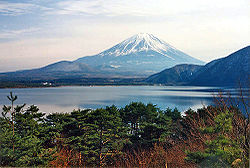
Mt. Fuji is the highest mountain in Japan, and one of the country’s most famous and instantly recognizable landmarks. The mountain, which is in fact a volcano, has been revered by the Japanese people for centuries. Mt. Fuji rises up from Yamanashi prefecture; it’s majestic peak widely visible for miles around, even from the bustling metropolis of Tokyo.
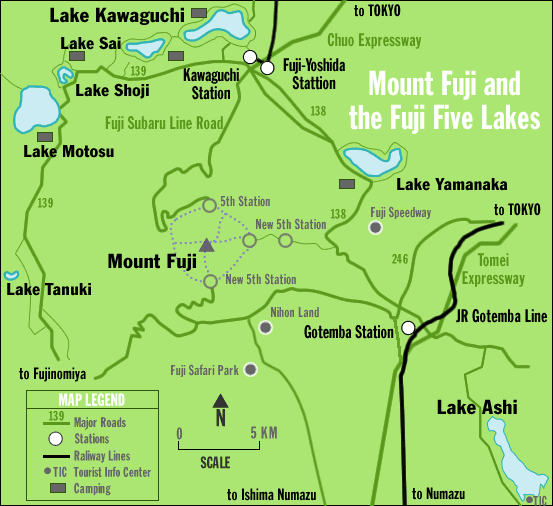
Few are aware that this picturesque locale is home to a mysterious animal, a strange lake creature affectionately referred to as “Mossie”, or “Mosse”, in the English spelling, and “モッシー” in Japanese. The creature is alleged to inhabit the five lakes that ring the foot of Mt. Fuji.
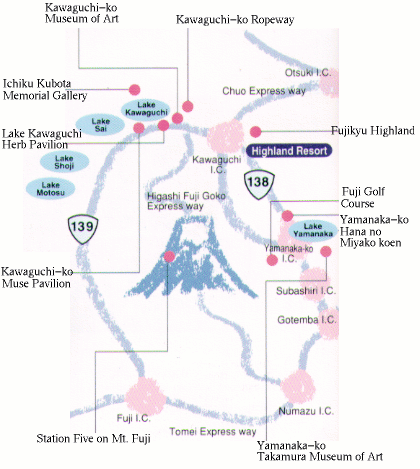
The Fuji Five Lakes, also known in Japanese as “Fujigoko,” are located in an arc around the northern half of Mt. Fuji. The lakes were formed by previous eruptions of Mt. Fuji, when volcanic lava flows blocked and dammed up rivers and streams to create the lakes. These five lakes are Lake Kawaguchi, Lake Motosu, Lake Saiko, Lake Shoji (the smallest of the five), and Lake Yamanaka, which is the largest of the five and also the third highest lake in Japan. The volcanic nature of the lakes’ creation has made for some interesting features. For instance, Lake Motosu is connected to Lake Saiko and Lake Shoji by a system of underground waterways, and some of the lakes still have visible protrusions of hardened lava.
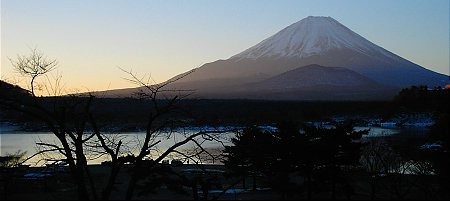
For years, the Fuji Five Lakes have been the setting for a series of strange sightings of an unidentified creature. During the 1970s, “Mossie” was brought to the attention of the general public due to a flap of sightings of something odd in the lakes. People were reporting large, black shapes or shadows in the water, as well as sudden, inexplicable wakes or surges, and the back of a mysterious animal.
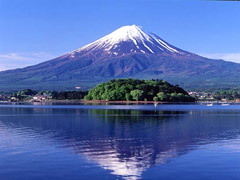
These sightings drew a lot of media attention and public interest at the time. One group of determined fisherman set about making a concerted effort to see if the strange animal could be captured. A network of sturdy nets were set up in an attempt to catch it, however, not long after it was discovered that the nets had been ripped apart by something large. Around the same time, some boats equipped with sonar equipment were scouring the lakes in the hopes of finding evidence of the creature, and a few of these reported picking up large, unexplained images.
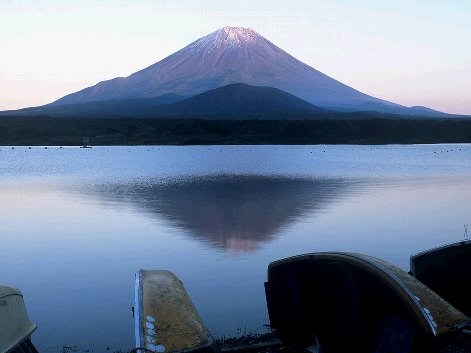
In the 1980s, sightings continued and the creature was even allegedly caught on film in October, 1987. A Mr. Yoneyama was out with three others taking pictures of the lake and its surroundings when they saw a surge of water out on the otherwise calm lake. Within this surge, they reported seeing 3 to 5 meters of the exposed back of something, which was described as being rough like that of a crocodile. They were able to capture the animal on film, but the results proved to be inconclusive.
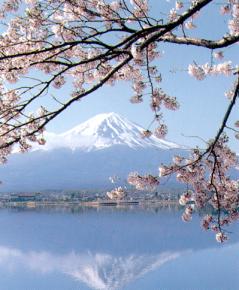
Mossie is reported as being up to 30 meters in length, with a horny, bumpy back like an alligator or crocodile. Some reports have also mentioned a long fin like that of a shark. The majority of sightings have been of large, dark shapes swimming under the surface of the water, with no details visible. Sightings of the animal have dropped off in recent years, but a group in the village of Kamikuishiki has been investigating the Mossie phenomena since 2005.
The question of what Mossie could be is complicated by the nature of the lakes themselves. The Fuji Five Lakes are not particularly ancient, being formed by volcanic activity that was relatively recent. It is thought that the lakes were formed by lava flows in the 9th and 10th centuries. This makes it impossible for the creature to be some type of prehistoric animal trapped in the lakes millions of years ago. There are no rivers or natural drainage connected to the lakes either, so there is no possibility that something has travelled there from the sea through this route. In addition, many of the fish in the lakes were stocked, and there is no species of fish known there that even approaches a size large enough to cause the reports. These facts make it difficult to determine just what Mossie is.
Nevertheless, there are some possibilities that we can speculate on. The lakes are popular fishing spots, and could possibly have been the target of people secretly releasing sport fish into the lakes. This sort of practice is not unheard of in Japan. For instance, the largemouth bass has been present in Japan since 1925, and was originally released more widely in 1977 in an effort to control populations of the invasive bluegill. Fishermen soon discovered the desirability of the bass as sport fish and it wasn’t long before the fish were being clandestinely and illegally released into lakes all over Japan, where they have since bred out of control to become the pest and threat to native species they are in many areas today. Perhaps something similar happened in the Fuji Five Lakes with other types of exotic fish?

Some point to giant carp (above) or giant catfish (below). While there are Crucian carp that live in the lake, these fish only reach sizes of around 3 and a half pounds or so.
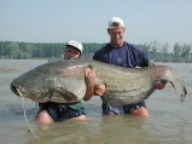
There are no large catfish known in the lakes either, so if Mossie were one of these, they would have to be introduced species such as the Siamese giant carp (Catlocarpio siamensis), or an introduced type of catfish capable of reaching huge sizes. These fish are considered a delicacy by many and are sought after fish, so perhaps someone could be inclined to introduce them to the lakes.
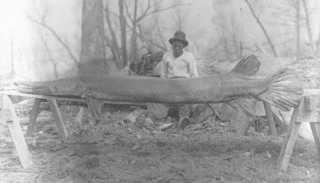
It has also been proposed that the culprit could be alligator gar (Atractosteus spatula), above. These fish reach lengths of 8 to 12 feet long, and have a very exotic appearance that many Japanese would not be used to seeing. However, their typical habitat is rivers, and it is thought that these fish require running water to spawn. This makes the Fuji lakes an undesirable habitat for alligator gar, considering these lakes are not connected to any rivers.
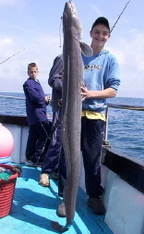
The idea of some very large type of eel (above) has also been considered. A large type of Southeast Asian eel has been released into Japanese lakes before, most notably in Lake Ikeda, which is incidentally the home of another Japanese lake monster, nicknamed “Issie.”
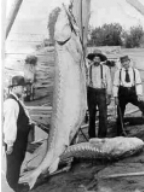
Then there is the inevitable suggestion that sturgeon could be behind the sightings. In this case, the possibility is supported somewhat by the descriptions and evidence. The mention of a rough and scaly back fits in well with sturgeon (above), which are covered with “scutes,” or large, bony plates, rather than scales. In addition, sturgeon can reach very large sizes, with lengths of 12 feet not unheard of. It is plausible that they could reach significantly larger sizes than this. Sturgeon are known to have been released into the Fuji Five lakes before, so it is known that they are there. However, sturgeon are largely benthic feeders, meaning they feed on the bottom, and they do not typically go near the surface where they would be seen.
One main problem with all of these candidates is the reported sizes of Mossie. None of these fish I have mentioned reach sizes anywhere close to 30 meters, which is the size described in some reports. Indeed these fish do not even approach 30 feet. Another point to consider is the well visited nature of the area involved. The Fuji Five lakes are a popular destination for tourists from all over Japan, who flock to the lakes for a wide range of activities, including camping, fishing, and water sports. Surely, a large creature in the lake would be spotted more frequently? The scenic views of Mt. Fuji also draw a large number of photographers, yet photographic evidence of Mossie remains extremely scarce.
Nevertheless, is there a chance that a large, unidentified creature is lurking somewhere in these lakes? Perhaps one of these animals is swimming out there right now, cutting a path through the reflection of Mt. Fuji upon the water.
Much appreciation to Brent for his guest blog. – Loren
About Loren Coleman
Loren Coleman is one of the world’s leading cryptozoologists, some say “the” leading living cryptozoologist. Certainly, he is acknowledged as the current living American researcher and writer who has most popularized cryptozoology in the late 20th and early 21st centuries.
Starting his fieldwork and investigations in 1960, after traveling and trekking extensively in pursuit of cryptozoological mysteries, Coleman began writing to share his experiences in 1969. An honorary member of Ivan T. Sanderson’s Society for the Investigation of the Unexplained in the 1970s, Coleman has been bestowed with similar honorary memberships of the North Idaho College Cryptozoology Club in 1983, and in subsequent years, that of the British Columbia Scientific Cryptozoology Club, CryptoSafari International, and other international organizations. He was also a Life Member and Benefactor of the International Society of Cryptozoology (now-defunct).
Loren Coleman’s daily blog, as a member of the Cryptomundo Team, served as an ongoing avenue of communication for the ever-growing body of cryptozoo news from 2005 through 2013. He returned as an infrequent contributor beginning Halloween week of 2015.
Coleman is the founder in 2003, and current director of the International Cryptozoology Museum in Portland, Maine.










It’s always a pleasure to read your posts Brent, that was very interesting.
From the info you provided, it seems that it would have to be something cryptid if there is indeed something in the lake. You ruled out all the known species, some based appearance and habitat, and all based on just size alone. I can’t think of anything other than a whale, based on the size reports, and like you said, that’s not even a jump that can be made since the lakes aren’t connected to the ocean/sea. It does make you wonder what tore the fishermen’s net, what could have possibly torn the net? I’m sure there are underwater caves associated with the lakes, and you mentioned a network that interconnected some of the lakes by underground waterways. So it kinda leaves you only to wonder about a possible undiscovered creature that can travel between lakes via the underground waterways.
So mossie was never popular enough for a group to use small, one person subs to see what’s down there? Jacque Cousteau’s group did this for Lake Tahoe, although they never released the film of their adventure saying, “The world isn’t ready for what we saw.” I would love to see that footage. The waters of the lakes in Japan look rather clear and serene, so searching there in this manner should work rather well. Thank you for discussing all thought of critters that could be the culprits. You said it was in the ’70’s when mossie was brought to the attention of the world, but is there any record or local talk about mossie before that?
Sorry for my question but isn’t モッシー more like moshi?
I should have left Tokyo when I lived in Japan. I thought their nature was rather boring and rather went to South East Asia as soon as I had a bit of time to spare. Seems I made a mistake:) I read these guest blogs and asked my Japanese friends about the creatures. No one has ever heard of them. Even Kappa is not very known among the people of Tokyo as far as I know. Maybe my friends are ignorant despite all of them being educated and intelligent:) As a side note I can recall that I have heard Kappa being used in the context of making fun of mentally handicapped people.
Interesting though is that my ex-wife claims that she saw a kappa when she was around 13-14 up in Miyagi. Of course she did not refer to a mentally handicapped person but to the strange creature.
Excellent post, as always, Brent.
Could the scarcity of reports from the lake be due to “Fortean,” i.e., supernatural reasons? Maybe it knows we’re watching. 🙂 Kidding.
Worth thinking about anyway. I know we tend to emphasize “scientific” explanations so we’ll stick to that, then. Just throwing out a suggestion. 🙂
Anyway, how deep is the lake? Is it as deep as Loch Ness?
That could be an explanation. Easy to hide in the deep lake.
And I do agree that not even catfish can get that big.
As always, great post, Brent. Keep it up.
cliffhanger042002- I’d say that if there really is something unusual there, and it isn’t just gross size misidentifications (12 feet for a sturgeon to 30 meters for some Mossie reports seems like a huge discrepancy), there is one other hypothesis I can entertain for how it might have gotten there.
Perhaps Mossie is a type of cryptid from the ocean that happened to have the habit of following salmonoid fishes up the rivers to feed on them, and when the lakes were formed by lava blocking off the river, the creatures were trapped in there. A very similar hypothesis has been suggested by some for the presence of Ogopogo in Okanagan Lake in British Columbia.
The problem I see with that idea in this case is that the lakes were formed in the 9th and 10th centuries, a time frame far beyond what I would expect for the life span of such a creature. It seems that there would have to have been more than one trapped in the lakes when Fuji’s eruptions occurred, a breeding population.
The net is curious, because there was a whole network used, and the type used are typically very sturdy. However, they may just not have been a type strong enough to handle a huge, non native fish like a sturgeon. There is also the possibility I suppose, that the damage done was exaggerated. It is a detail of the case that does make me wonder though.
Shumway- Well, Mossie was popular enough at the time for boats to use sonar equipment, but I’m not aware of any effort to use mini subs. It seems to me that perhaps most efforts to track the creature were more based on whimsy and an effort to drum up tourism than out of any real effort to find anything. I’m fairly positive no one was throwing a lot of money into it. Mossie also fell into obscurity pretty quickly and nowadays it is one of Japan’s more little known cryptids.
It appears that locals have been seeing strange things in the Lake since before the 70s, but it is really difficult to track down any sightings reports from before then since it wasn’t really in the public eye and I suppose not taken seriously. The creatures were known to the people of the area, but these people either felt no need to report it, or no one was willing to publish it. It seems it wasn’t until the flap of tourist sightings in the 70s brought Mossie into public consciousness that some locals were coming out and saying “Well yeah, we’ve been seeing this thing for years.”
cryptidsrus- I suppose it could be Fortean in nature but I’m more willing to look at the more rational possibilities first. 🙂
As for the depth of the lakes, the deepest of the Fuji Five Lakes is Lake Motosu, which is 138 meters deep (453 feet) at its deepest point. That is a far cry from Loch Ness, which reaches a maximum depth of 230 meters (754 feet).
If the creature was mostly a benthic, bottom dweller, then this would be more than deep enough to hide it, though. If it stayed at the bottom, it could avoid tourists’ prying eyes and cameras. If it is a bottom dwelling water breather, this could also explain why the creature isn’t seen in full view at the surface very often.
cryptidsrus- I forgot to mention though, that the shallowest of the Fuji Five Lakes is Lake Shoji, with an average depth of only 3.7 meters and 15 meters at its deepest point.
Shumway- I also meant to address what you said about the clarity of the lakes. I wouldn’t say that all lakes in Japan are that clear, but the Fuji Five Lakes certainly are. They are all known as being very clear lakes. Indeed, Lake Sai (Saiko), is often called “The Lake of the Maiden,” and is considered one of Japan’s clearest with its beautiful blue, highly transparent water. Lake Motosu is also known for being extremely clear. This good water visibility makes the lakes popular with scuba divers, who go down to see craters and lava formations from the great eruptions, as well as huge, preserved trees from the time. Interestingly, I have not found a single report of Mossie being seen by a diver.
Storfoot- That Japanese (モッシー)would look like “Mosshii” if one were to spell it directly from the katakana, but the English spelling of the creature’s name is typically written as “Mossie,” or “Mosse.”
Oh yes, you most certainly should have gotten out of Tokyo! Japan has some of the most beautiful wilderness areas I’ve ever seen. 🙂
A lot of these cryptids that I write about are obscure, but not all. Many of them are well known by Japanese interested in cryptozoology, and written of extensively on Japanese UMA (Unidentified Mystery Animal) sites. Even the obscure ones can be found in Japanese cryptozoological literature, where is where I get a lot of my information.
Many Japanese people may only know about the big ones, and only know the others if they have an interest in such things. If they are not into this stuff, then I’m not too surprised they would not have heard much of Kappa, or Tsuchinoko, or Hibagon for instance. You might be amazed how many people here are unaware that there was once a type of wolf in Japan (the Honshu wolf), even though it was a known animal. (It’s now thought to be extinct). One of my main goals with writing these pieces is to share information on these cryptids (including for Japanese 🙂 ), and hopefully expand the English literature on them while I’m at it.
I suppose it is the same with cryptids anywhere else. Someone who knows what Bigfoot is might not have ever heard of something like, say, a Ropen. Likewise, it’s not as if all American cryptids are known to all Americans. I’m very well read in cryptozoology, and I still often come across cryptids I have never heard of, even ones from my home country. For awhile, many Australians had no idea what a Yowie was. The same thing holds true in Japan.
Your friends may be very intelligent, but if they are not out reading up on the cryptozoology of their own country, then of course I wouldn’t expect they have heard of some of the creatures I’ve covered.
Storfot- Something that might help explain the spelling of “Mossie,” is that this word was meant to emulate the word “Nessie,” a foreign word for Japanese, which, like “Mossie,” is written in katakana (for those who don’t know, Katakana is a writing system typically used for foreign or loan words). In it’s Japanese spelling, “Nessie” would be “ネッシー.” That would translate directly to “Nesshii,” which is not how it is spelled in English.
The exact same thing goes for “Mossie” becoming “Mosshii.” It has to do with the phonetics of the Japanese kana. “Mosshi” is a corruption of “Mossie”, due to the phonetic limitations of the Japanese kana alphabet, of “Mossie,” which is what they are really trying to say and which is how the name is meant to look. Same as what happened to Nessie’s name when transferred to Japanese.
So often with foreign words written in Japanese, such as Nessie or Mossie, you will get these differences.
Storfot- I’d like to give more details for future reference for you or anyone else here interested in the linguistics behind some of the Japanese words or spellings I will sometimes use in these articles on Japanese cryptids.
The phonetic limitations of the Japanese alphabet will often mean that some words will not directly correspond to their English spellings or pronunciation. In my example above with “Mossie,” the difference concerns the lack of a “si” (pronounced see) in Japanese. The closest in Japanese is “shi”. (シ in katakana for loan words, and し in hiragana). For example, “Nessie” becomes “Nesshi” (ネッシー), “seatbelt” becomes “shiitoberuto” (シートベルト)and so on. Incidentally, the consonants of Japanese words will almost always have a vowel attached (except for a lone “n”), as you can see in the “seatbelt” example above.
Any Japanese words I use in these articles that are from foreign words (like Mossie), will have sometimes have these differences I’ve described. This is why the two spellings or pronunciations may not always be the same between languages.
Not to go into a language lesson here, but I just thought I would clear this up. The differences you may see lie in the inherit limits of the languages involved, not because of laziness or inaccuracy on my part.
M_M – I agree with that theory and what you’re saying. If it isn’t “very gross” size misidentifications it would have to be something like a Blue Whale, if the size reports are accurate, and there would have to be a breeding population. That being said, I think if there was a breeding population of Blue Whale, or any other species of whale, then there would probably exist hard evidence since the whale would have to come up for air fairly often. I would think that anyone spending just a couple hours gazing over the lake (just watching the calm surface) would notice the breaks or disruptions in the lake surface when a whale would come up for air. And since the lakes are a hotspot for nature enthusiasts, campers, hikers, etc., it seems like there would be a high level of consistent, numerous reports. Since that is not the case though, for me it only leaves 2 possibilities: 1.) unknown creature. 2.) legend/myth created either by pure fabrication or possibly just exaggerated tales of misidentification.
Of course I would love for it to be #1 🙂
Brent: if you took the photos, you are exposing yourself to the charge of being multi-talented. 🙂
Sounds like Nessie to me, minus the publicity push. Right down to what-the-heck-is-it? and that sneakin’ suspicion I always get that sometimes shapes in the water are no more than that.
But could a couple submersibles hurt things any?
Cliffhanger- Yeah, whales don’t really seem to fit the bill, do they? These lakes are not particularly huge or deep and have high tourist traffic. If there was a population of landlocked blue whales there that had on top of that managed to survive and breed in their new freshwater environment, they would most certainly be seen more often. It just doesn’t seem to hold up as a logical explanation.
I’m more inclined to think that if Mossie is a real creature, whatever it is, it is likely a water breathing, quite possibly benthic animal that rarely comes to the surface.
DWA- A couple of submersibles wouldn’t hurt. The water in these lakes is so clear compared to a place like Loch Ness, that there’s a chance that they could turn up something interesting. I do find it curious though, that as far as I know, no scuba divers in the lakes (of which there are quite few) have ever reported anything out of the ordinary.